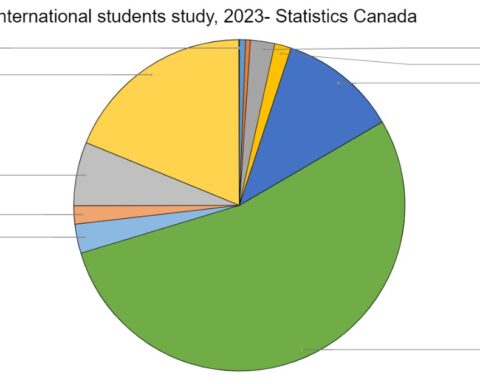In September 2022, a 24-year-old international student phoned a settlement agency in the Toronto area in distress. Due to a lack of social connection and academic stress, he had slipped into depression. He could not find any foothold here or share his troubles with his parents back in India. He had stopped eating for three days, and when he managed to call the crisis line, he kept crying for a long, nerve-chilling 15 minutes.
“We were compelled to refer him to a local crisis line as he was not eligible for our crisis counselling service,” the manager of the settlement agency recollected.
The student’s plight highlights how helpless settlement workers feel every time distressed temporary migrants reach them, adding, “we have to work within the purview of the settlement policies governing our work.”
The unsettling story speaks volumes about the cracks thousands of foreign workers and students are falling through in Canada each day due to the lack of federal government-funded settlement services which are critical to their integration and survival in Canadian society. Add to this: The distressed student’s location in Ontario was a double-whammy because work permit holders and students are ineligible for most provincially funded settlement services in Ontario, unlike in provinces such as Nova Scotia and British Columbia.
Settlement services offered by Immigration, Refugees and Citizenship Canada (IRCC) help newcomers integrate well into their new lives in Canada. However, IRCC’s wide range of services like employment support, language training, and crisis counselling are available only for permanent residents, refugees, and protected persons (outside Quebec). On the other hand, settlement services are limited and inconsistent in most provinces, leaving thousands of students and work visa holders without the necessary help.
Immigration policy experts say that foreign workers and students should have equal access to all integration services (whether funded by IRCC or a province) because they too are key contributors to the Canadian economy. And advocates across all sectors demand a collective response from all the stakeholders including IRCC, provinces, academic institutions and employers, to plug the existing gaps in serving this population.
What are settlement and newcomer services?
Remi Lariviere, Media Relations, Communications (IRCC) wrote to New Canadian Media (NCM) that the primary objective of its Settlement Program is “to support the social and economic integration of permanent residents so that they can succeed and contribute to Canadian society over the long-term.”
Lariviere pointed out that temporary residents become eligible for federal government-funded settlement services as soon as they attain approval-in-principle for permanent resident status. Applicants to the Atlantic Immigration Program and the Rural and Northern Immigration Pilot, including international graduates and temporary foreign workers, are eligible for select IRCC-funded settlement services.
Traditional policy framework in the background
Sandra Schinnerl, a postdoctoral fellow at the University of British Columbia’s Centre for Migration Studies, sees an underlying “tension” between the old way of receiving immigrants and recent changes in policy.
Many immigrants now come as temporary residents and then apply for permanent residency. But the settlement services funding model and the mandate of IRCC haven’t kept pace with the change. The traditional immigration trends offered no “pathways” from temporary to permanent residency. One had to apply outside of Canada to become a permanent resident and would arrive in Canada with that status.
She points out how immigration trends have changed substantially — for students since the early 2010s and quite dramatically since 2014 — when additional changes were introduced to immigration policy and immigration pathway opportunities.
Available supports are inadequate and inconsistent
At the provincial level, eligibility criteria for settlement services are not uniform. While in Quebec, foreign students can get online French language training and other integration services for free, in Nova Scotia international post-secondary graduates with valid work permits, who intend to stay can also access the settlement services. British Columbia funds settlement services “for temporary residents and naturalized Canadian citizens”, whereas in Ontario, the settlement funding doesn’t have the scope and scale of the federally funded program and is mainly limited to information-sharing and referral services for students and work visa holders.
Jagdeep Kailey, Manager of Settlement Services at Peel Multicultural Council in the Greater Toronto Area, explains that newcomer services offered to students under Ontario provincial funding are more like ‘touch and go’. They cannot be referred for language classes or for any employment support. He suggests that academic institutions should work with community organizations and set aside funds to help these students.
Associate Professor, Sutama Ghosh of Toronto Metropolitan University blames shrinking provincial funding for the gaps. She says that though a provincial government benefits the most from its taxpayers, including temporary migrants, it uses public-private partnerships as a way to evade responsibility when it comes to offering basic services like integration support to this population. “Neither these private agencies like employers or institutions, nor the provincial government are coordinated to work together, leading to large-scale confusion on whose responsibility it is to look after the welfare of the students or work permit holders,” she said.

Though temporary migrants are eligible for services from other funders such as regional development agencies, community-based organizations, and even post-secondary institutions, the reality is that they often find the integration supports sparse. Professor John Shields, also from Toronto Metropolitan University, highlights that during and after the pandemic, funding at several non-profit organizations shrank, and coupled with human resource challenges, has left this “invisible population” to fend for themselves.
Who is responsible for finding a solution?
An employee of another settlement agency in GTA shared with NCM, “We often see female temporary migrants seeking employment support to plan a safe exit from domestic violence. It’s heart-breaking to say ‘No’ to them because they are ineligible for the service here and in many provinces.” The community-builder who runs advocacy programs for South Asian female immigrants requested anonymity to protect her job, explained that these women on temporary work visas are often left stranded in toxic relationships with their partners because of a lack of outside support.
“I always wonder, if these households pay taxes as much as citizens and permanent residents and are considered crucial to Canada’s short-term economic recovery following the pandemic, and to its long-term growth, why don’t they receive these vital supports?” she said.
Schinnerl recommends that instead of debating who should pay for gaining access to current services available to permanent residents, there should be conversations about “how we can create a system that best serves the needs of this major source of permanent (and temporary) immigration to Canada.”
In fact, the Ontario Council of Agencies Serving Immigrants’ (OCASI) 2023 federal pre-budget submission contains recommendations to “open access to federally funded immigrant settlement services to all who need it (at an estimated cost of $5 million a year).” OCASI’s Amy Casipullai shared with NCM, “We have been advocating for a very long time — certainly more than a decade about this. We hope more voices join us in this call.”
Experts believe that academic institutions and employers also have a critical role to play, considering the direct financial benefits they enjoy and their capability to understand the circumstances of the people who wish to immigrate in the future.
Schinnerl says some of these services may be best provided within higher education institutions, others within settlement organizations, still others by employers.
Talking about IRCC’s resistance to making changes to its eligibility criteria, Prof. Shields advises that the federal government treat the cost implication as a long-term investment.
“If employers move in this direction and initiate support to the migrants with job-specific language skills and integration measures so that there is a stable workforce, it will be easier to convince the governments to get on board and start a dialogue with all the stakeholders.”
Amrita is an NCM-CAJ Collective Member, journalist and content writer, with nearly a decade of experience in content development and journalism in three countries. She started her career as a journalist with a leading daily, The Statesman, in India. She has also led content and editorial teams for several web content management firms. Amrita served as a Communications and Content specialist for some non-profit organizations like the American Red Cross after her move to the U.S. Based out of Toronto, she continues to follow her passion by reporting on human rights violations, education, crimes, inequality and community engagement. Amrita holds a Post Graduate Diploma in Print Journalism from Chennai, India.





